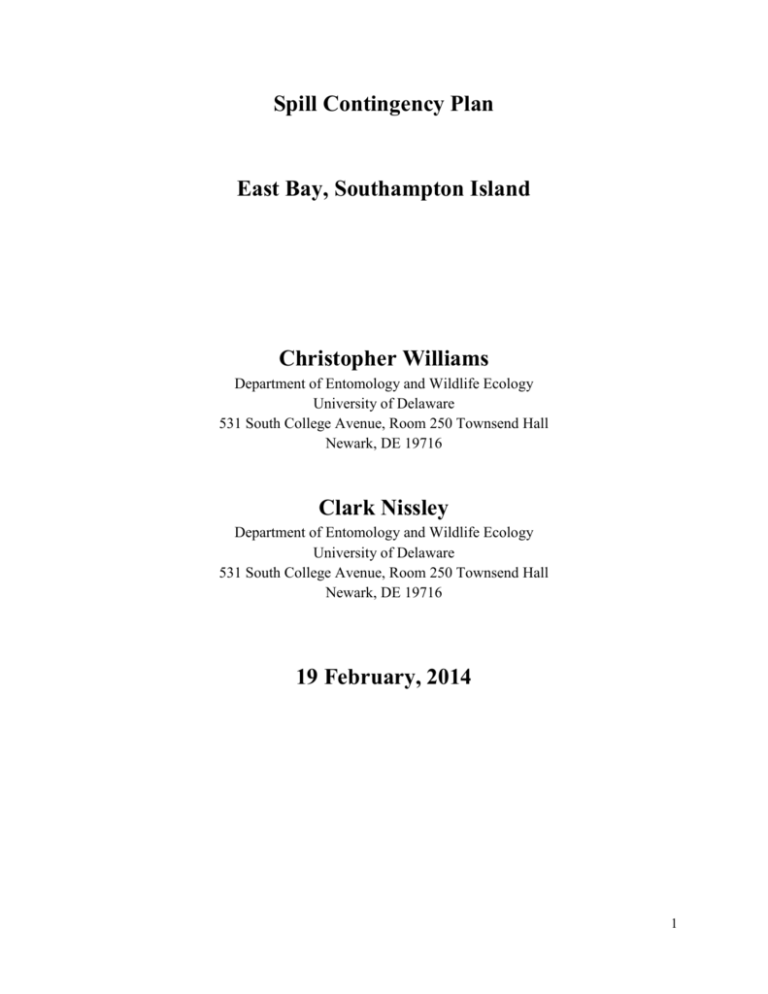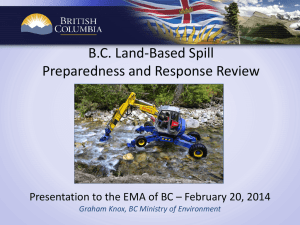140320-14YN007-Spill Plan
advertisement

Spill Contingency Plan East Bay, Southampton Island Christopher Williams Department of Entomology and Wildlife Ecology University of Delaware 531 South College Avenue, Room 250 Townsend Hall Newark, DE 19716 Clark Nissley Department of Entomology and Wildlife Ecology University of Delaware 531 South College Avenue, Room 250 Townsend Hall Newark, DE 19716 19 February, 2014 1 Table of Contents Section Page Site……………………………………………………………………………….8 Location………………………………………………………………………….8 Person in Charge…………………………………………………………………8 Person Responsible for Activating Spill Plan……………………………………8 Spill Plan Effective Period……………………………………………………….8 Description of Field Site…………………………………………………………8-9 Spill Kit Contents………………………………………………………………..9 Spill Plan Actions………………………………………………………………..9 Contacts………………………………………………………………………….9-10 Spill Report Associated Forms and Materials Information………………………11-25 2 Site: East Bay Mainland, Southampton Island Location: 63°57’580 N 81°51’29 W Persons in Charge: Dr. Christopher Williams Department of Entomology and Wildlife Ecology University of Delaware 531 South College Avenue, Room 250 Townsend Hall Newark, DE 19716 Dr. Kenneth Abraham Environmental and Life Sciences Graduate Program Trent University 2140 East Bank Drive, DNA Building Peterborough, Ontario K9J 6B8 Person Responsible for Activating Spill Plan: Clark Nissley is the camp crew leader for both the 2014 and 2015 field season. Remote camp does not have a telephone line so this is not applicable. Clark Nissley will notify appropriate agencies via satellite telephone or 2-way radio. Spill Effective Period: 2014 and 2015, May 15th-July 30th Description: The camp is located on a gravel ridge on East Bay, Southampton Island. The camp is supplied by a twin otter on skis in May. The camp will consist of two longhouse tents provided by the Polar Continental Shelf Program. One of those tents is used as a sleeping tent and the other is used as a cooking/gear storage tent. These structures will rest on cobble-sized stones surrounded by little vegetation (a small amount of moss). Fuel (propane) will be stored near the camp (above the ocean high water line), in 20 lb tanks. These materials will be located on a flat location, with a small berm built around them in the event of a fuel spill. An emergency spill kit with absorbent materials and protective gloves will be kept at the camp near the fuel storage in the event of a spill. When practical all sumps will be located above 30 m above the high water line. These will be back-filled, mounded, and contoured to match surrounding landscape prior to leaving the camp. Current MSDS will be kept in a central location (the storage/kitchen tent) so as to be accessible to all personnel. 3 To reduce solid waste, packaging of material brought to the island will be kept to a minimum, and will be reused whenever possible. Spill Kit Contents: 30 Absorbent Pads (Oil, Gas) 15 Universal Absorbent Pads 2 18” x 18” Oil Absorbent Pillows 3 3” x 4’ Absorbent Socks (Oil, Gas, Diesel) 6 HD Hazmat Disposal Bags 2 Pairs of Nitrile Gloves 1 Spill Instruction Sheet 1 Laminated List of Contents 1 Jar of “Plug and Dike” Hazardous Leak Sealant General Actions: In advance of any possible spill and upon arrival at the field camp, all people at the field site will be made aware of all the protocols below, proper protocols for handling, storing, and pouring fuel and the contact information should a spill occur. In the event of a fuel spill near the camp: Notify research crew leader of the spill and its location so that they can activate the spill plan Do not flush materials into water courses Ensure berm is working to stop the movement of any fuel Spills will be inherently small because little is stored at the site, so use absorbent materials in spill kit to soak up Notify Polar Shelf via satellite phone or radio, and have them notify the Spill Line Fill out the Nunavut Spill Report Form (http://www.nunavutwaterboard.org) Contacts: In the event of a spill, the following agencies must be contacted: Polar Shelf in Resolute: (867) 252-3872, or use two-way radio 24 Hour Nunavut Spill Line: (867) 920-9130 Ph., (867) 873-6924 Fx Peter Kusugac, INAC Manager of Field Operations: (867) 975-4295 Ph., (867) 975-6445 Fx 4 Environment Canada in Iqaluit: (867) 975-4644 Department of Fisheries and Oceans, Central and Arctic Regional Offices: (204) 983-5000 Kivalliq Inuit Association (867) 645-2800 5 6 7 8 9 10 11 12 13 14 15 16 17 18 19 20







